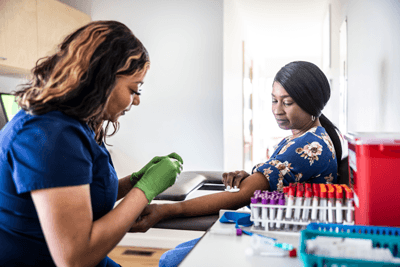Tests and scans
Tissue typing is a set of tests that are done with your blood and saliva. You might have it if your doctors think that you need a from someone else (donor transplant). It is to show how closely a possible stem cell or bone marrow donor’s tissue matches your own.
You might also hear this test called other names such as:
HLA tissue typing
HLA typing
Histocompatibility testing
HLA crossmatching
You usually have one or more of the following tests:
a blood test
a swab taken from the inside of your cheek (buccal swab)
a spit (saliva) sample
HLA stands for human leucocyte antigen. They are proteins that are found on the surface of most cells in your body. HLA proteins are important as they help your immune system figure out which cells in your body are yours and which are not (foreign). If your immune system picks up a foreign cell then it triggers an .
Each person has their own specific set of HLA proteins that they have inherited from each parent. Doctors in the laboratory can check the blood and saliva sample for the HLA proteins (or HLA markers). They check for 10 HLA markers.
The result of this test shows how good the HLA match is between you and the person who might be able to donate their cells. Your doctor wants the best match so there is less chance that your immune system will reject the donor’s blood cells. You might hear them say you have a 10 out of 10 match or a 9 out of 10 match.
Your medical team will talk to you about which members of your family can be tested. This is usually your siblings.
You can eat and drink normally before your test. Take your medicines as normal.
You should not eat, drink, smoke or chew gum for 30 minutes before giving this sample.
You sit or lie down to have the test.
A doctor, nurse or phlebotomist (person specialised in taking blood) chooses the best vein to use. This is usually from your arm or hand. Let them know if you are afraid of needles, get unwell with the sight of blood or are allergic to plasters or latex.
They put a tight band (tourniquet) around your arm above the area where they take the sample. You may need to clench your fist to make it easier to find a vein.
They clean your skin and then put a small needle into your vein. Next, they attach a small bottle or syringe to the needle to draw out some blood. They might fill several small bottles.
Once they have all the samples, they release the band around your arm. They then take the needle out and put pressure on the area with a cotton wool ball or small piece of gauze for a few minutes. This helps to stop bleeding and bruising.
Look away when they’re taking the blood if you prefer. Tell your doctor, nurse or phlebotomist if you feel unwell.

The swab looks like a very long cotton bud. You or your nurse can do it. If doing it yourself it might be best to do it by looking in the mirror.
Your nurse might ask you to sit upright in a chair or if you prefer you can stand.
The nurse or you will then remove the swab from the packet. Do not allow the tip of the swab to touch anywhere else apart from the inside of your cheek. You or the nurse then rubs the swab on the inside of your cheek for several seconds. The swab is then placed into the tube to be sent to the laboratory.
You sit upright in a chair or if you prefer you can stand. You then spit the saliva into the container. This then sent on to the laboratory for testing.
Ask when to expect your results and how you will receive them.
Contact your specialist nurse if you have any questions about tissue typing or bone marrow transplants.
These are very safe tests. There are possible risks if you are having a blood test. These might include:
bleeding and bruising - pressing hard when the needle is removed can help to stop it
pain - this is normally mild and can last for a few minutes
swelling (oedema) - ask your nurse, doctor or phlebotomist to avoid an arm that is swollen or has a risk of swelling
feeling faint or fainting - tell the person doing your blood test if you're feeling lightheaded or dizzy at any time
infection - this is very rare
Last reviewed: 29 Jun 2021
Next review due: 29 Jun 2024
Find out about tests to diagnose cancer and monitor it during and after treatment, including what each test can show, how you have it and how to prepare.
Stem cell or bone marrow transplants are treatments for some types of cancer including leukaemia, lymphoma and myeloma. You have them with high dose chemotherapy and sometimes radiotherapy.
Blood cancers affect the production and function of your blood cells. There are 3 main types - leukaemia, lymphoma and myeloma. There are also other conditions that are similar that can affect these cells.
There are many different types of leukaemia and the treatment varies for each of them. Get information about the main types.
Acute lymphoblastic leukaemia (ALL) starts from young white blood cells called lymphocytes in the bone marrow. Find out about symptoms, tests to diagnose, treatments and how to cope.

About Cancer generously supported by Dangoor Education since 2010. Learn more about Dangoor Education
What to ask your doctor about clinical trials.
Meet and chat to other cancer people affected by cancer.
Questions about cancer? Call freephone 0808 800 40 40 from 9 to 5 - Monday to Friday. Alternatively, you can email us.